Easy Sheet Pan Salmon Healthy and Quick Dinner Recipe
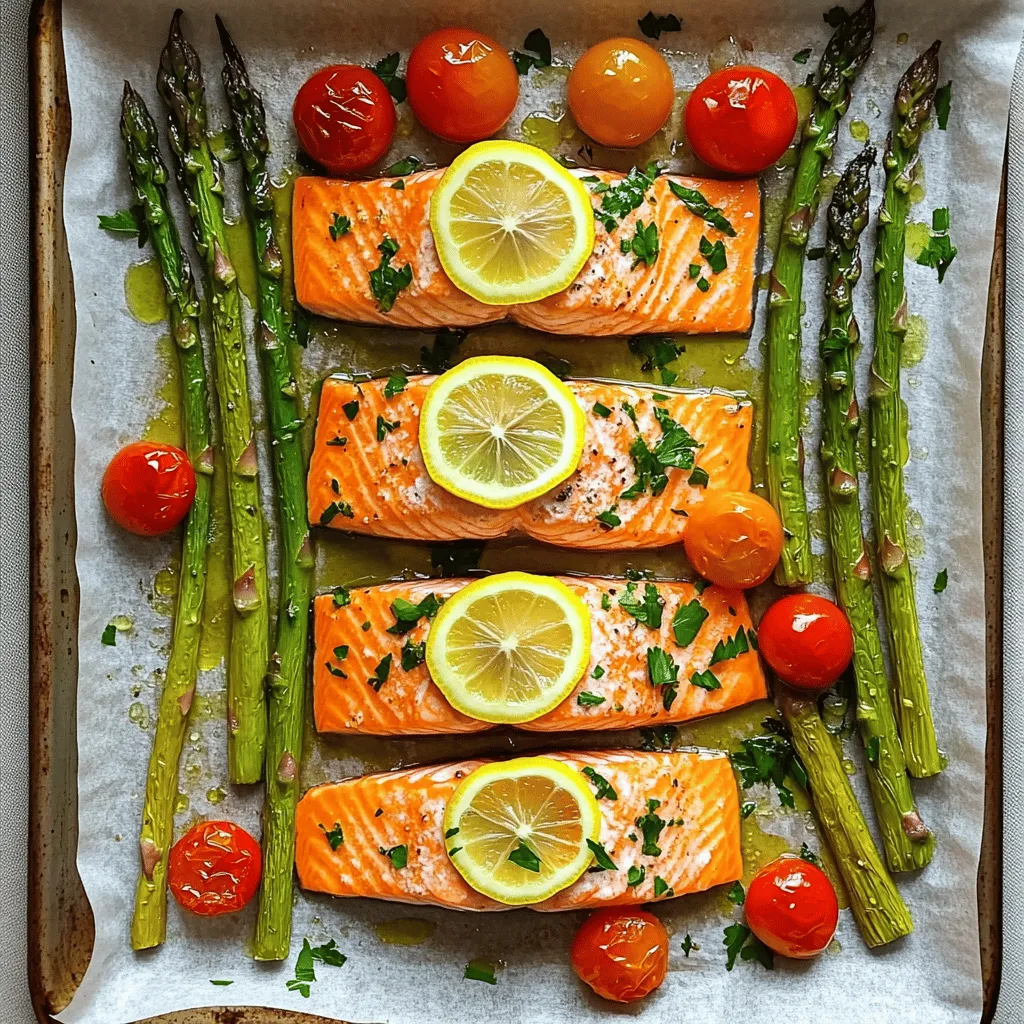
Looking for a quick, healthy dinner? You’re in the right place! This Easy Sheet Pan Salmon recipe is fast, flavorful, and a breeze to clean up. With tender salmon and vibrant veggies roasting together, you’ll have a meal that pleases everyone. Perfect for busy weeknights or relaxed weekends, this dish brings nutrition and taste in just a few simple steps. Let’s dive into making your dinner stress-free!
Ingredients
Salmon Fillets
You need 4 succulent salmon fillets. Look for fillets that are fresh and firm. Each piece should be about 6 ounces. This amount serves four people well. Salmon is rich in omega-3 fatty acids, adding health benefits to your meal.
Vegetables
For veggies, gather 1 zesty lemon, sliced into rounds. You will also need 2 cups of fresh asparagus. Trim the woody ends for the best texture. Plus, use 1 cup of vibrant cherry tomatoes, halved. These colorful veggies add flavor, color, and nutrients to your dish.
Seasoning and Garnish
For seasoning, mix together 3 tablespoons of extra virgin olive oil, 2 teaspoons of garlic powder, and 1 teaspoon of smoky paprika. Add salt and freshly cracked black pepper to taste. This blend enhances the salmon’s natural flavor. Finally, chop fresh parsley for garnish. It adds a bright touch to your dish.
Find the full recipe for more details!
Step-by-Step Instructions
Preparation Steps
First, we need to get ready. Preheat your oven to 400°F (200°C). This temperature works great for roasting. Next, grab a large sheet pan. Line it with parchment paper to help with cleanup. Now, we can place the salmon fillets in the center. Make sure they have some space around them. This helps them cook evenly.
Trim the woody ends off the asparagus. Then, cut the cherry tomatoes in half. Arrange the asparagus and tomatoes around the salmon. This makes your dish look vibrant and colorful.
In a small bowl, mix three tablespoons of olive oil, two teaspoons of garlic powder, and one teaspoon of smoky paprika. Add salt and pepper as you like. This mix will add a lot of flavor. Use a brush to coat the salmon with this oil mixture.
Cooking Process
Now, it’s time to cook! Lay a slice of lemon on each salmon fillet. This will give a fresh taste as it roasts. Place the sheet pan in the oven. Roast for around 15 to 20 minutes. The salmon is done when it flakes easily with a fork.
Keep an eye on it! Ovens can vary, so check a bit early if you’re unsure. Once it’s cooked, take the pan out of the oven. Sprinkle some fresh parsley on top for a nice touch.
Serving Suggestions
For serving, use a large platter for a beautiful display. Arrange the salmon fillets with the colorful veggies. Add extra lemon slices and parsley for a nice look. This dish not only tastes great but looks amazing too. Enjoy it with friends or family!
For the full recipe, check out the details provided earlier.
Tips & Tricks
Best Cooking Temperatures
The ideal temperature for cooking salmon is 400°F (200°C). This heat allows the salmon to cook evenly. It also gives a nice sear on the outside while keeping the inside moist and tender. Always preheat your oven to this temperature before placing your salmon in.
How to Test Salmon for Doneness
To check if salmon is done, use a fork to gently flake the fish. If it flakes easily, it is ready. Look for a light pink color in the center. You can also use a food thermometer. The internal temperature should be 145°F (63°C). This ensures it’s safe to eat while still juicy.
Ways to Enhance Flavor
There are many ways to boost the flavor of your salmon. Here are some of my favorites:
– Add fresh herbs like dill or thyme for a burst of freshness.
– Include a splash of soy sauce or honey for a sweet and savory mix.
– Try different citrus fruits, like lime or orange, to change the taste.
– You can also top with nuts or seeds for crunch and nutrition.
These tips will help you make your Easy Sheet Pan Salmon even more delightful. For the full details on how to prepare this dish, check out the Full Recipe.
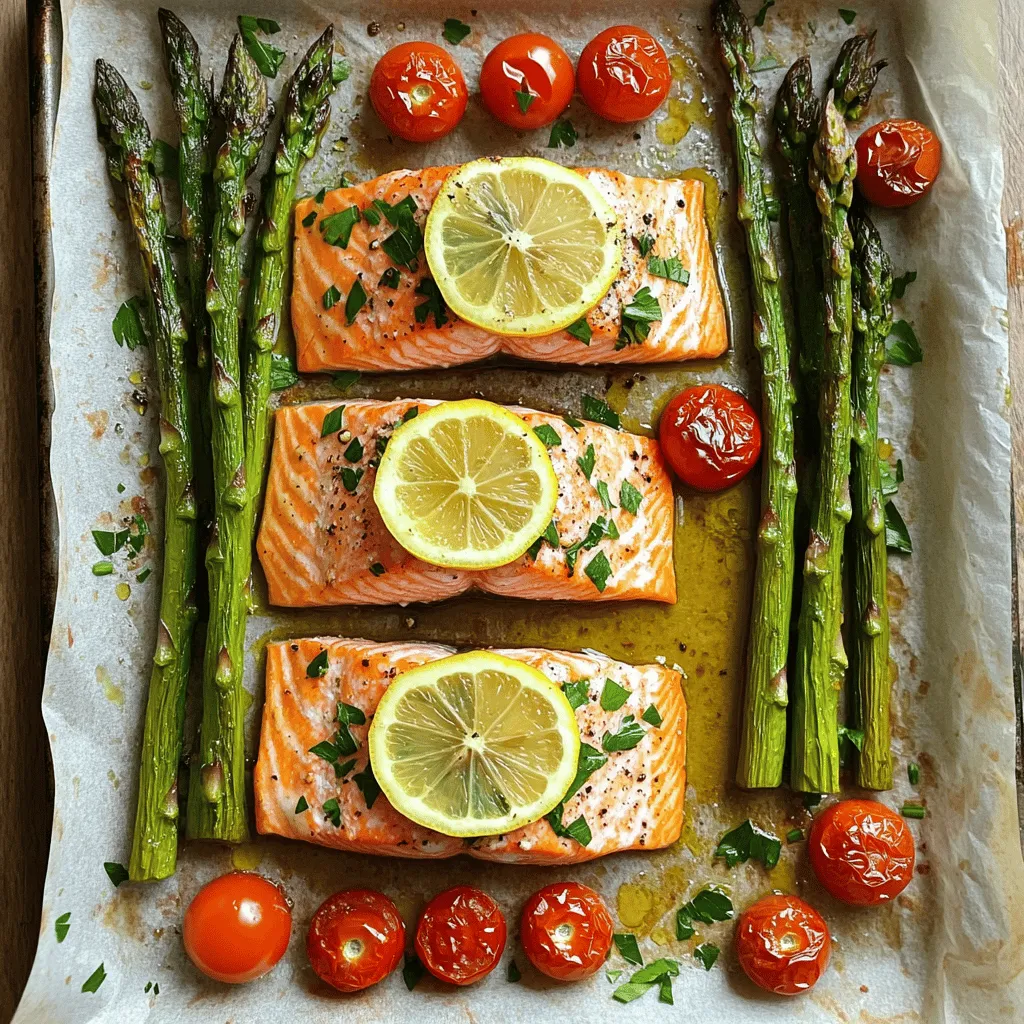
Variations
Alternative Vegetables
You can swap the asparagus and tomatoes for other veggies. Try broccoli, bell peppers, or zucchini. Each brings its own taste and texture. Roasting adds a nice char and sweetness. Just ensure they cook well in the time it takes for the salmon.
Different Seasoning Blends
Change up the seasonings to match your taste. For a spicy kick, use chili powder or cayenne. For a more herbal touch, try dill or thyme. You can even mix in some soy sauce for an Asian twist. These options give the dish a new life each time.
Serving with Side Dishes
Pair your salmon with easy sides. Quinoa or brown rice makes a great base. You can also serve with a fresh salad or roasted potatoes. These sides balance the meal and add more nutrients. Check out the Full Recipe for ideas on presentation!
Storage Info
Refrigerating Leftovers
Store your leftover salmon in an airtight container. Place it in the fridge within two hours of cooking. This keeps it fresh and safe to eat. Your salmon will last for up to three days in the fridge. If you want to keep the veggies, store them in a separate container.
Freezing Recommendations
To freeze your salmon, wrap it tightly in plastic wrap. Then, place it in a freezer bag. Make sure to remove as much air as possible. You can freeze it for up to three months. When you are ready to eat it, thaw it overnight in the fridge before reheating.
Reheating Instructions
To reheat salmon, preheat your oven to 350°F (175°C). Place the salmon on a baking sheet. Cover it with foil to keep it moist. Heat for about 10 to 15 minutes. If you prefer, you can also microwave it. Use a microwave-safe dish and cover it. Heat on low power for one to two minutes until warm.
FAQs
How long does it take to cook salmon on a sheet pan?
Cooking salmon on a sheet pan takes about 15 to 20 minutes. The key is to cook it at 400°F (200°C). When the salmon flakes easily with a fork, it is done. This quick cooking time makes it perfect for busy nights. Pair it with fresh veggies for a full meal.
Can I use frozen salmon for this recipe?
Yes, you can use frozen salmon for this recipe. Just make sure to thaw it first. Place the frozen salmon in the fridge for several hours or overnight. You can also run it under cold water for quick thawing. Once thawed, follow the same cooking steps.
What flavors pair well with salmon?
Salmon pairs well with many flavors. Here are some top choices:
– Lemon: Adds a bright, fresh taste.
– Garlic: Offers a rich flavor that enhances the fish.
– Dill: This herb adds a light and fresh touch.
– Honey: A bit of sweetness balances the fish’s richness.
– Soy sauce: Adds a savory, umami kick.
Feel free to mix and match these flavors to create your favorite taste!
This blog post covered everything you need to know about cooking salmon. We discussed key ingredients like salmon fillets, veggies, and spices. You learned step-by-step how to prepare, cook, and serve. The tips shared helped ensure perfect salmon every time. We explored tasty variations to keep meals exciting. Lastly, I provided storage advice and answered common questions.
With this knowledge, you’re set to enjoy delicious salmon dishes, no matter the occasion.
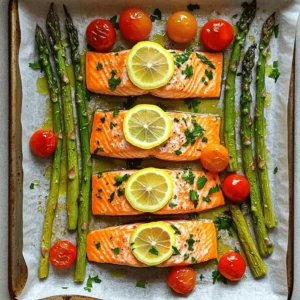
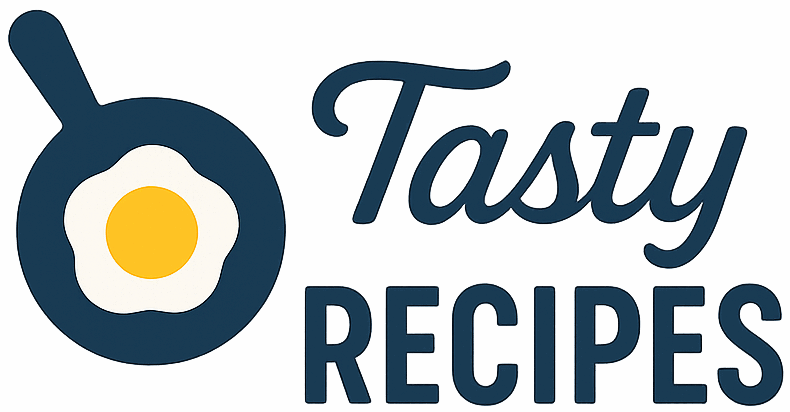
. Heat 1 tablespoon of olive oil in a large pot over medium heat. Once the oil is hot, add 1 diced onion and 1 diced bell pepper. Sauté them for about 5 minutes. You want the onion and pepper to be soft and slightly see-through. Now, add 2 minced garlic cloves to the pot. Stir it for 1 minute until the garlic smells great and turns a light golden color. This step adds a nice depth of flavor. Next, raise the heat to medium-high and add 1 pound of ground beef. Use a wooden spoon to break it apart. Cook until the beef is brown, which should take about 7 to 10 minutes. If there is a lot of grease, drain it off. Turn the heat down to medium. It's time to add the spices! Stir in 2 tablespoons of chili powder, 1 teaspoon of cumin, 1 teaspoon of smoked paprika, ½ teaspoon of dried oregano, 1 teaspoon of salt, and ½ teaspoon of black pepper. Cook for another 2 minutes. This helps the spices mix well and create a rich flavor. Pour in 1 can of crushed tomatoes, 2 cans of kidney beans (drained and rinsed), and 1 cup of beef broth. Stir everything to combine well. Bring the chili to a simmer, then lower the heat to low. Cover the pot and let it cook for at least 30 minutes. For even more flavor, let it simmer for up to an hour. Stir occasionally for the best results. Now, you can check out the Full Recipe for more details! To make your chili just right, adjust the seasonings to match your taste. Start with the basic spices in the recipe. You can always add more, but it’s hard to take away. If you want extra heat, add crushed red pepper or diced jalapeños. A little goes a long way, so start small. You can always taste and add more. For a richer flavor, try using smoked paprika instead of regular paprika. It gives a nice depth to the dish. You can also add a splash of vinegar for a tangy kick. This brightens up the chili and balances the richness of the beef. When cooking chili, I recommend using a heavy pot. A Dutch oven works great for even heating. It helps all the flavors mix well. Avoid using thin, non-stick pots. They can cause hot spots and burn your chili. Common mistakes include not browning the beef enough. Take your time when cooking the beef until it’s nicely browned. This step adds a lot of flavor. Also, don’t rush the simmering time. Letting the chili simmer allows all the flavors to blend. The longer it cooks, the better it tastes. For the best results, always taste your chili before serving. Adjust the salt and spices if needed. This final check ensures your chili is perfect. Follow these tips, and you’ll serve a chili that everyone loves. For the full recipe, check out the details above. {{image_4}} You can use other meats in this chili. Ground turkey is a lean choice. It tastes great and lowers fat. You can also try plant-based meats. These options work well for flavor and texture. They can make a hearty meal too. Substitute the beef with the same amount of turkey or plant-based meat. Keep the cooking steps the same for a tasty dish. Want a meat-free chili? It’s easy! Replace the ground beef with more beans. You can use black beans, pinto beans, or chickpeas. Add extra veggies like carrots or zucchini for depth. Instead of beef broth, use vegetable broth. This will keep it full of flavor. You won't miss the beef at all with these swaps! Want to kick up the flavor? Add corn for sweetness and crunch. Diced jalapeños can bring heat; adjust to your taste. You might also try different beans, like cannellini or navy beans. Each bean adds unique texture and taste. Toss in some bell peppers for color and flavor. Customize your chili with these easy additions! For the full recipe, check out the Hearty Kickin' Beef Chili. To keep your beef chili fresh, store it in an airtight container. Let it cool first. Place it in the fridge if you plan to eat it in a few days. Chili stays good for about 3 to 4 days in the fridge. If you want to keep it longer, freeze it. Use freezer-safe containers or bags to prevent freezer burn. Label your containers with dates to track freshness. Chili can last up to 3 months in the freezer. When ready to eat, reheating chili is easy. You can use the stovetop or microwave. For stovetop, place the chili in a pot over low heat. Stir it often to avoid sticking. Heat until it’s hot all the way through. If using a microwave, put the chili in a microwave-safe bowl. Cover it loosely and heat in short bursts. Stir between each burst to ensure even heating. This keeps the flavor and texture just right. To add heat, you can use several options. Try adding chopped fresh jalapeños or serrano peppers. You can also mix in some red pepper flakes or cayenne pepper. For a smoky flavor, consider chipotle peppers in adobo sauce. These ingredients boost the heat without overpowering the chili's taste. If you prefer, you can also serve hot sauce on the side. This way, each person can spice their bowl to their liking. Yes, you can easily make this chili in a slow cooker. First, brown the beef in a pan to add flavor. Then transfer it to the slow cooker with the other ingredients. Set it on low for 6-8 hours or high for 3-4 hours. This method allows the flavors to meld beautifully. Just make sure to adjust the liquid if needed, as slow cookers retain moisture well. Beef chili lasts about 3-4 days in the fridge. Store it in an airtight container to keep it fresh. Always check for signs of spoilage before eating. If you see any mold or if it smells off, it's best to throw it away. You can also freeze chili for up to 3 months for longer storage. Just thaw it in the fridge before reheating. Serve beef chili hot in bowls. A sprinkle of fresh cilantro adds color and freshness. You can offer sour cream and shredded cheese as toppings. Crushed tortilla chips or cornbread make great sides. For a fun twist, try serving chili over rice for a hearty meal. You can also pair it with a crisp salad for balance. Yes, this recipe is gluten-free. Most of the ingredients do not contain gluten. However, always check the labels on canned goods. Some brands might add gluten-containing additives. If you want to be extra cautious, use gluten-free broth and spices. This ensures that everyone can enjoy your hearty kickin' beef chili without worry. For the full recipe, click [Full Recipe]. This post gave you a clear recipe for a tasty beef chili. You learned about key ingredients, step-by-step cooking, and fun variations. Plus, I shared valuable storage tips to keep your chili fresh. Remember, cooking is fun, and you can always tweak flavors to your liking. Try swapping meats or adding spices to make it yours. Enjoy crafting your perfect bowl of chili!](https://tastyrecipes.blog/wp-content/uploads/2025/06/f60abddc-d55f-446a-b6cb-23ad9744c5ad-768x768.webp)
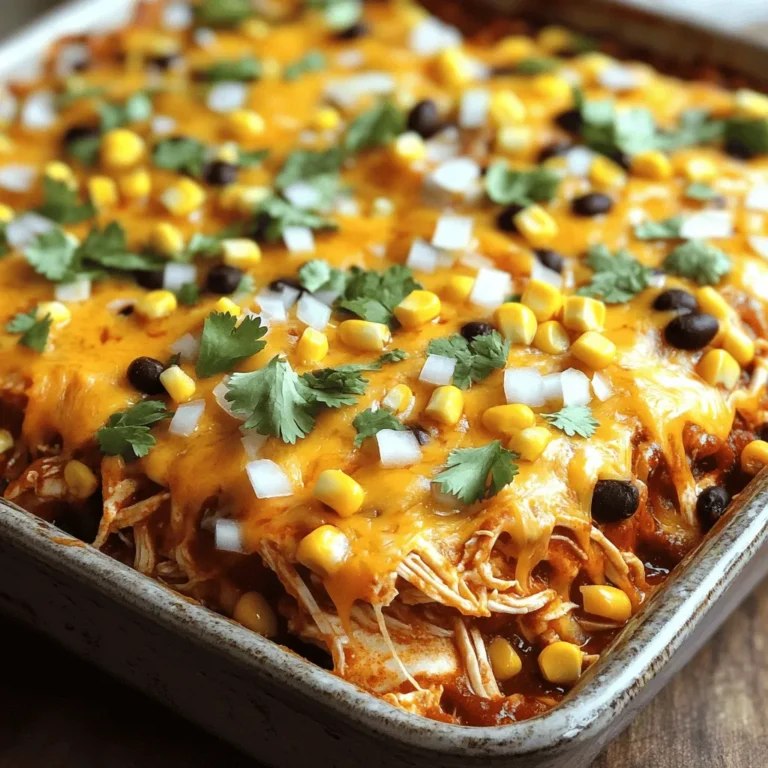
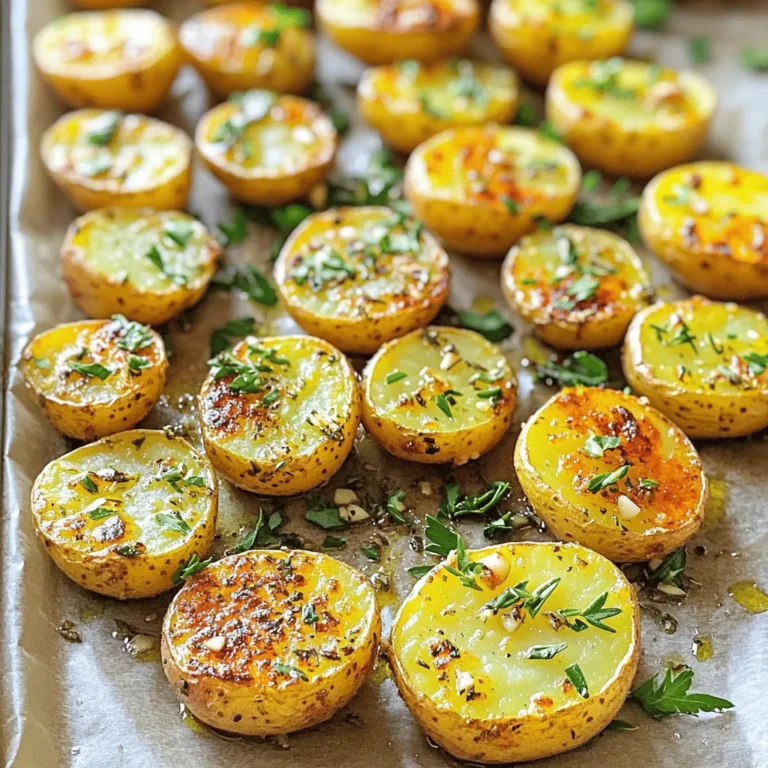
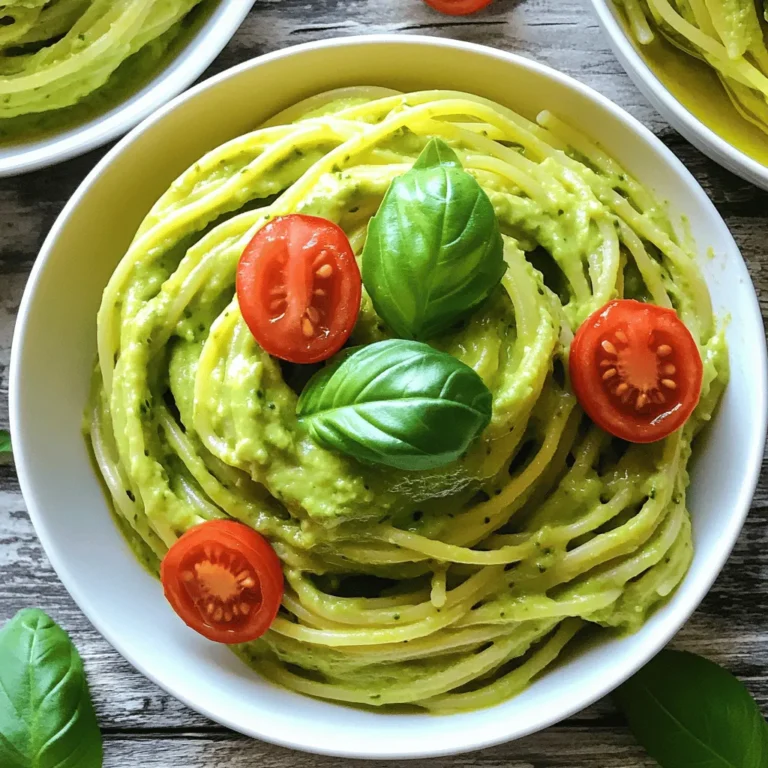
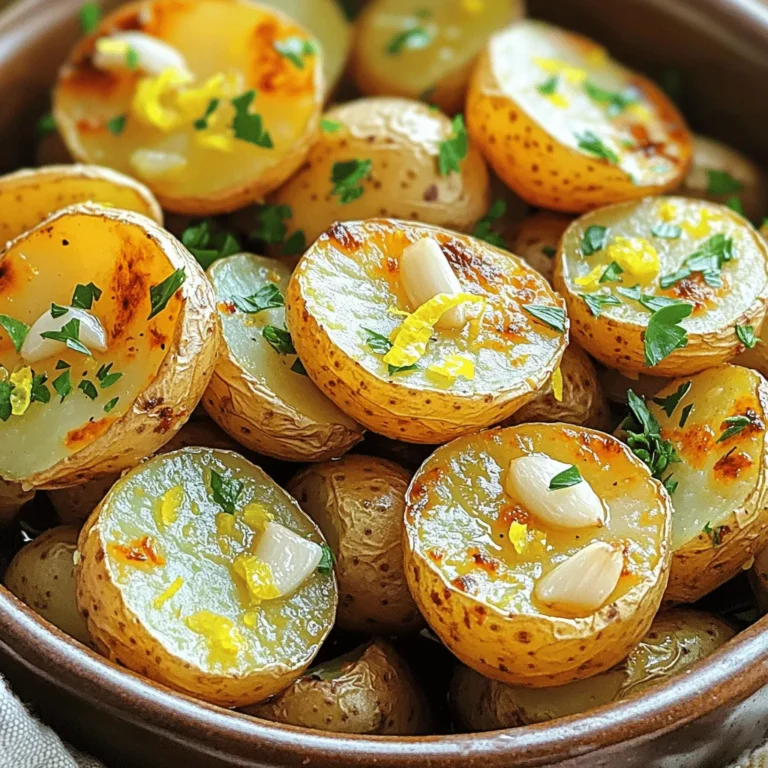
![When making taco stuffed zucchini boats, you'll need simple ingredients that pack a punch. Here’s what you need: - 4 medium zucchini - 1 tablespoon olive oil - 1 pound ground turkey or beef - 1 small onion, finely diced - 2 cloves garlic, minced - 1 cup canned black beans, rinsed and drained - 1 cup corn (frozen or fresh) - 1 packet taco seasoning - 1 cup diced tomatoes (fresh or canned) - 1 cup shredded cheese (cheddar or Mexican blend) - Fresh cilantro, chopped, for garnish - Sour cream or Greek yogurt, for serving (optional) - Lime wedges, for serving These ingredients work together to create a dish that is not only tasty but also low in carbs. The zucchini acts as a healthy base, while the taco filling adds a burst of flavor. You can find the full recipe at the end of this article. It shows you how to bring all these ingredients together into a meal that everyone will love. - Preheat the oven to 375°F (190°C). This ensures the zucchini cooks evenly. - Take each zucchini and cut them in half lengthwise. Use a spoon to scoop out the center, making a boat shape. Keep the flesh you scoop out for later. - In a large skillet, heat the olive oil over medium heat. Add the diced onion and minced garlic. Sauté for about 3-4 minutes until the onion is soft and smells good. - Next, add the ground turkey or beef to the skillet. Break it apart with a spatula while it cooks. Cook for around 5-7 minutes until it’s nicely browned. - Stir in the reserved zucchini flesh, black beans, corn, taco seasoning, and diced tomatoes. Cook this mixture for another 5 minutes. Make sure everything is warm and mixed well. - Now, take the hollowed zucchini boats and place them in a baking dish. Fill each boat with the taco meat mixture, packing it in for a hearty meal. - Sprinkle the remaining shredded cheese on top of each boat for a cheesy finish. - Cover the baking dish with aluminum foil and bake in the oven for 25 minutes. After that, remove the foil and bake for another 10-15 minutes. The zucchini should be soft, and the cheese should be bubbling and golden. - Once done, take the zucchini boats out of the oven and let them cool for a few minutes. Before serving, add freshly chopped cilantro for extra flavor. For the full recipe, refer to the complete instructions provided. To keep your zucchinis tender but not mushy, choose medium-sized ones. Larger zucchinis can hold too much water. Cut them in half lengthwise and scoop out some flesh, but leave enough to keep them sturdy. Bake at 375°F (190°C) for the best texture. For perfectly melted cheese, use shredded cheese rather than slices. Layer the cheese on top of the filling before baking. Remove the foil during the last baking phase to let the cheese brown. This step adds flavor and texture. To enhance your meal, serve with sour cream or Greek yogurt. Lime wedges add a zesty touch. You can also pair these boats with a fresh salad or tortilla chips for crunch. For a stylish presentation, place the zucchini boats on a wooden platter. Drizzle with sour cream and sprinkle with cilantro right before serving. This makes for a colorful, eye-catching dish that impresses guests. For a vegetarian option, use beans and lentils in place of meat. You can also add extra veggies to the filling for more flavor and texture. If you need a dairy-free version, skip the cheese or use vegan cheese alternatives. Coconut yogurt can replace sour cream. These small changes keep the dish delicious while meeting your dietary needs. For the full recipe, check out Taco Stuffed Zucchini Boats. {{image_4}} You can easily switch up the protein in your taco stuffed zucchini boats. If you want a lighter option, try using chicken. Ground chicken is a great choice. It cooks quickly and takes on flavors well. If you prefer a meatless dish, use beans instead. Black beans or pinto beans work nicely. They add protein and fiber while keeping it hearty. To kick up the heat, add spicy elements. Jalapeños bring a nice zing, while cayenne pepper adds a bold flavor. If you enjoy the crunch, toss in some chopped bell peppers or corn. You can also add diced onions or mushrooms for extra texture and taste. Mixing in these veggies makes each bite more exciting! You can give your zucchini boats an international flair. For a Mexican touch, top with guacamole or pico de gallo. The creaminess of avocado balances the spices. If you want a Mediterranean twist, sprinkle some feta and add olives. This mix creates a fresh and tangy flavor that pairs well with the zucchini. These variations let you explore new tastes and keep your meals fun! For the full recipe, check out [Full Recipe]. To store leftover taco stuffed zucchini boats, let them cool first. Place them in an airtight container. They will stay fresh for up to four days in the fridge. The zucchini should remain firm, and the filling will hold its flavor well. To freeze the zucchini boats, wrap them tightly in plastic wrap. Then, place them in a freezer-safe bag. They can last up to three months in the freezer. When ready to eat, thaw overnight in the fridge. Reheat in the oven at 350°F (175°C) until heated through. This helps keep the flavor and texture intact. You can prepare the filling in advance. Cook the meat and mix in the other ingredients. Store this mixture in the fridge for up to three days. When you're ready to eat, simply fill the zucchini and bake. Aim for one boat per serving for easy meal planning. This helps save time and makes healthy eating simple. For more ideas, check the Full Recipe for variations. Can I use different types of meat for the filling? Yes, you can use any ground meat you like. Ground chicken, pork, or even plant-based meat work well. Each meat brings its own flavor, so feel free to experiment! How do I make taco stuffed zucchini boats vegan? To make this dish vegan, swap meat for lentils or black beans. Use vegan cheese or skip it entirely. You can add more veggies for texture and flavor. Can I prepare the filling in advance? Absolutely! You can cook the filling a day ahead. Store it in the fridge. Just reheat it before stuffing the zucchini. What can I do with leftover zucchini flesh? You can add the leftover zucchini flesh to soups, stir-fries, or salads. It’s great for adding nutrients and flavor. How do I know when the zucchini is done baking? The zucchini is done when it feels tender when pierced with a fork. The cheese on top should be bubbling and golden. What is the best way to cut zucchini for stuffing? Cut the zucchini in half lengthwise. Use a spoon to scoop out the center flesh. This creates a nice boat shape for filling. What are some good side dishes to serve with this recipe? Serve with a fresh salad, guacamole, or corn tortillas. Rice or quinoa also pairs nicely for a full meal. How can I spice up my taco stuffed zucchini boats further? Add jalapeños for heat or top with salsa. Fresh herbs like cilantro or a squeeze of lime can enhance the flavor too. For the full recipe, visit the provided link and enjoy your cooking adventure! This blog post shared a simple recipe for taco stuffed zucchini boats. I covered the ingredients, step-by-step cooking instructions, and tips for tasty results. You can adapt this dish for various diets and enjoy fun flavors. These stuffed zucchini boats are easy to make and full of nutrition. With a few simple swaps and creative touches, your meal can please everyone at the table. Now, it's your turn to cook and impress!](https://tastyrecipes.blog/wp-content/uploads/2025/06/beefab14-0b63-40b8-b221-b583c53af4aa-768x768.webp)